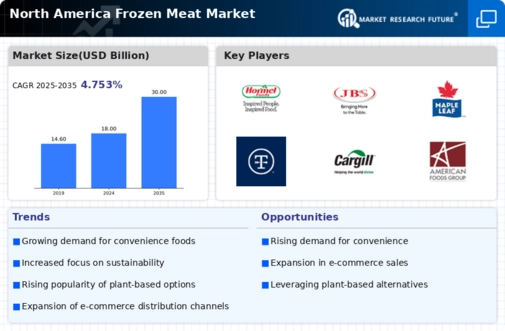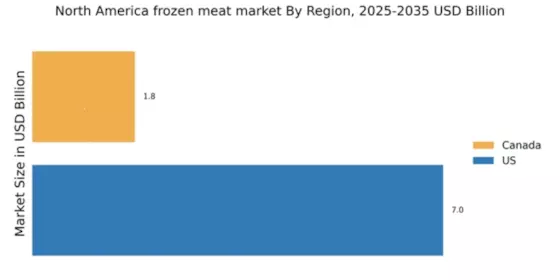Innovations in Freezing Technology
Advancements in freezing technology are playing a pivotal role in the frozen meat market. Innovations such as flash freezing and cryogenic freezing are enhancing the quality and texture of frozen meats, making them more appealing to consumers. These technologies help preserve the freshness and flavor of meat products, which is essential for maintaining customer satisfaction. Furthermore, the implementation of improved packaging solutions is also contributing to the market's growth by extending shelf life and reducing waste. As these technologies become more widely adopted, they are expected to drive the frozen meat market forward, attracting both new and existing customers who prioritize quality.
Rising Interest in Protein-Rich Diets
The frozen meat market is witnessing a surge in interest surrounding protein-rich diets. As consumers increasingly recognize the importance of protein for health and wellness, the demand for frozen meat products is likely to rise. This trend is particularly evident among fitness enthusiasts and health-conscious individuals who seek convenient sources of high-quality protein. Data indicates that the protein-rich food market is projected to grow at a rate of 6% annually, which bodes well for the frozen meat sector. The availability of various frozen meat options, including lean cuts and specialty products, aligns with this dietary shift, positioning the frozen meat market favorably in a competitive landscape.
Expansion of Retail Distribution Channels
The frozen meat market is benefiting from the expansion of retail distribution channels across North America. Supermarkets, convenience stores, and online grocery platforms are increasingly stocking a diverse range of frozen meat products. This expansion is crucial as it enhances accessibility for consumers, allowing them to purchase frozen meats with ease. Recent statistics suggest that online grocery sales have surged, with frozen food categories experiencing a significant uptick. The convenience of home delivery services further supports this trend, as consumers seek to minimize shopping time. Consequently, the growth of retail distribution channels is likely to bolster the frozen meat market, catering to the evolving shopping habits of consumers.
Growing Awareness of Food Safety Standards
The frozen meat market is experiencing heightened awareness regarding food safety standards among consumers. As foodborne illnesses remain a concern, consumers are increasingly scrutinizing the safety and quality of meat products. Regulatory bodies in North America have implemented stringent guidelines to ensure the safety of frozen meats, which has positively influenced consumer trust. This growing awareness is likely to drive demand for frozen meat products that meet or exceed safety standards. Additionally, brands that prioritize transparency in sourcing and processing are likely to gain a competitive edge in the market. As a result, the focus on food safety is expected to play a crucial role in shaping the future of the frozen meat market.
Increased Consumer Preference for Frozen Products
The frozen meat market in North America is experiencing a notable shift in consumer preferences towards frozen products. This trend is driven by the convenience and longer shelf life that frozen meats offer, allowing consumers to stock up without the immediate pressure of spoilage. Recent data indicates that the frozen meat segment has seen a growth rate of approximately 5% annually, reflecting a growing acceptance among consumers. Additionally, the ability to maintain nutritional value during the freezing process appeals to health-conscious buyers. As busy lifestyles become more prevalent, the demand for frozen meat products is likely to continue rising, positioning the frozen meat market as a key player in the overall food sector.


















Leave a Comment